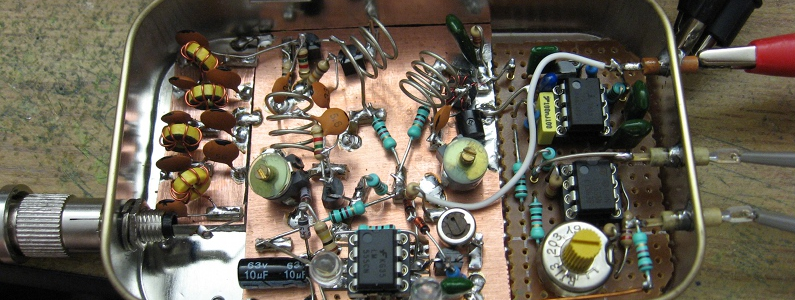[VK2ZAY] has a thing for 555 chips. Before the ready availability of microcontrollers, the 555 was the hardware hacker’s swiss army knife. After all, even though the chip is supposed to be a timer, it is really a bunch of simple pieces you can use to make a timer: a pair of comparators, a few transistors, and a flip-flop. You can use those parts in many different ways, and a timer is just one of them.
[VK2ZAY] used one as a key component in a simple spectrum analyzer. The 555 generates a ramp voltage which alters the frequency of an oscillator. The oscillator mixes with the input signal and a fixed-frequency superregenerative detector creates an output voltage proportional to the input signal strength. You can see a video of the whole setup, below.
Simple and elegant. Not the best performing spectrum analyzer you can find, but it does the job and it fits in an Altoid tin. Generating a ramp isn’t too far of a stretch for a 555, but we’ve seen [VK2ZAY] abuse 555s far worse.
If you want to know more about the 555, you can get all forensic with [Ken Shirriff]. Or you can look at its guts on a more macro level, if you prefer.
















Absolutely fantastic piece of work. Great video too!
Great job. I wish I could understand how it works.
+1
That is beautifully done!
Depending on the application the output looks surprisingly usable!
Wow vk2zay aka Alan Yates has a sweet YouTube channel full of cool electronics goodies, I suppose it’s not as active these days since he’s been helping build us the awesome HTC Vive hardware at Valve.
The “poor mans spectrum analyzer” from 73 zine back in the 80-90 era, used a 555 and a cable tuner for some agility. I have one unfinished on my bench, dusty. Mine is just FM band and the whole tuner is a Pioneer car tuner module that uses the S meter out for scanning. It makes a decent ‘video’ for spectrum display. So mine was dustbin stuff to start with.
That’s a work of art! Those springy things must be homebrew aircore inductors?
I think those are the loosely-coupled inductors that provide the feedback path for the superregenerative detector. the fact that they’re oriented parallel to each other means the field from either affects the other.
Okay, why are you making my brain hurt? I’ve been working with RF for a very long time, and I’ve never heard anything described as a “superregenerative spectrum analyzer”, a “superregenerative superhetrodyne receiver”, or anything with a parameter called “quench” that could be measured in kilohertz. And then, most emphatically NOT any such thing whose “quench frequency” is proportional to the log of the signal level, feeding a frequency-voltage converter. Whew. I would suspect that this was something on par with the Turboencabulator (https://www.youtube.com/watch?v=rLDgQg6bq7o), except that this one sounds slightly less plausible.
Fortunately, a quick trip to https://en.wikipedia.org/wiki/Regenerative_circuit convinces me that these are real things and makes me all better. I learned something today – thank you for making my brain hurt.
Okay, why are you making my brain hurt? I’ve been working with RF for a very long time, and I’ve never heard anything described as a “superregenerative spectrum analyzer”, a “superregenerative superhetrodyne receiver”, or anything with a parameter called “quench” measured in kilohertz. And then, most emphatically NOT any such thing whose “quench frequency” is proportional to the log of the signal level, feeding a frequency-voltage converter. Whew. I would suspect that this was something on par with the Turboencabulator (https://www.youtube.com/watch?v=rLDgQg6bq7o), except that this one sounds slightly less plausible.
However, a quick trip to https://en.wikipedia.org/wiki/Regenerative_circuit convinces me that these are real things and makes me all better. I learned something today – thank you for making my brain hurt.
very, very old tech, old but good ;)
hmm. “Uploaded on Jan 30, 2011”
maybe it’s a generational thing :)